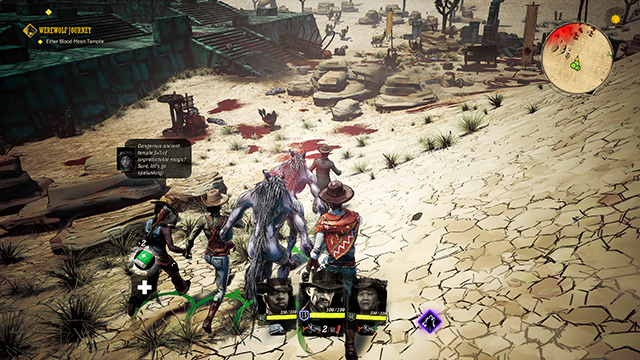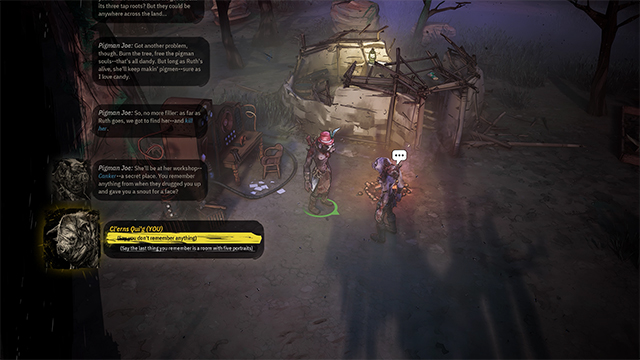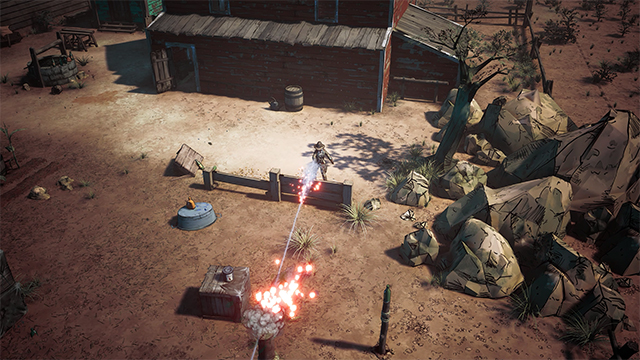Arkane Studios is known for its first-person immersive sims like Dishonored and Prey. Both titles are liberating sandboxes with a ton of interlocking tools that constantly interact and bounce off each other to create unique, player-driven moments. Wolfeye Studios is hoping to expand upon that idea, but in a different way through Weird West. This isometric RPG may not look nothing like those aforementioned Arkane games and it remains to be seen if it can match them, but it’s got many of the same systems-driven gameplay pillars.
The link makes sense as 15 out of the 25 team members are straight from Arkane, including Raphael Colantonio who founded Arkane in 1999 and is the creative director on Weird West. In a hands-off demo, Colatonio explained how the team wanted to dig deeper into immersive sims. This includes many of the staples of the genre including always saying “yes” to the player, having non-linear exploration, containing multiple playstyles, and rewarding experimentation.

Weird West is pushing forward with giving each player a unique playthrough through dynamic event generation. Colantonio explained it as an AI that waits for “opportunistic moments to throw something at the player.” These can have consequences, too, which allows for even more variation and potential for unique playthroughs.
Weird West’s gameplay seems to be an amalgamation of these types of random events as well as what the player can directly control. Environments are littered with an abundance of random items that can be interacted with. Players can pick abilities from a few upgrade trees that give them unique moves during the frantic, gun-focused combat, allowing them to craft their own playstyle. They can also choose between stealth and loud gunplay (but players can’t play non-lethally as it’s “not the game for that”). Day and night can change enemy patterns or what types of flammable objects can be exploited. Buildings and fortresses can be infiltrated in a number of different ways (and every single building can be breached in some way). Story moments have branching options.
MORE: That’s No Moon. It’s an Ambitious New Game Studio.
Murdering a bunch of NPCs can lead to abandoned towns where a random enemy faction can move it. Players can even explore around and find objectives before even getting the mission assigned. Weather patterns can affect the playfield in different ways. For example, rain can make dynamite practically useless while tornadoes can pick up fire and become a flaming cyclone of death. There are even other more mysterious supernatual twists, which was something Colantonio explained as something that allowed for more emergent gameplay systems.
“The reason we like the supernatural stuff is flavor,” he explained. “There’s more to discover and it gives more possibilities during gameplay. If you can come up with some crazy magic stuff then more fun stuff can happen.”

It’s not quite clear how much these realistic and arcane systems will allow for creative problem solving that the best types of these games have. However, the elements seem to be there for an engaging immersive sim that has faint echoes of a game like Dishonored, but the isometric viewpoint seems a tad antithetical to the “immersive” part of “immersive sim.” There’s a reason many of the best games in the genre like Deus Ex, Prey, Bioshock, and Skyrim are often in first-person: It puts the player closer into the action. Zooming the camera out puts a barrier between the user and the game and subsequently seems a little detached.
MORE: Interview: That’s No Moon Leads Talk About Returning to Single-Player Action Adventure Games
The isometric viewpoint is a result of the smaller team size and just one of the limitations Wolfeye had to work within. Making a game with realistic visuals probably wasn’t in the cards, which is why the game has a stylized art direction that was influenced by French comics. This cheaper approach means it has a lot of ink and simplified textures, according to Colantonio. This approach was easier than a more realistic game as that would require resources Wolfeye does not have. Colantonio said he sees this as “more recognizable and more ownable” than something with fewer constraints as the saturated look allows for it to look more timeless. In practice, it does look unique and almost like a Telltale game, but zoomed out.

It also doesn’t have much voice acting, which can mean players will be spending a lot of time reading. Colantonio said this allowed them to be more nimble and make changes at the very last minute if they needed to. Wolfeye is a remote developer without a central office, too, so it would also likely be much harder to constantly re-record lines.
Weird West is a lot to take in and, frankly, isn’t a type of game that demos well in small doses. Games like this thrive on seeing their multiple options clash and play out over a period of time. Showing that off in a limited, hands-off setting is tough since it truncates the freedom that sits at its core along with any possible payoffs that might happen later on. Weird West has the potential to be a deep action RPG with many interlocking systems as it has talent experienced in that field behind, but it’s going to hard to see how wild this West is until it comes out later this year.










